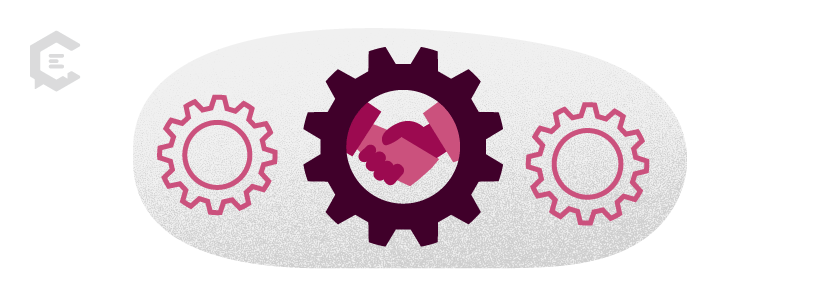In content marketing, it’s essential to connect with your audience.
Customer Relationship Management empowers your business to do just that. Understanding its intricacies can be your ticket to capturing your audience’s attention and nurturing lasting relationships.
In this article, we’ll dive into CRM in the context of content marketing, break down its common uses, and showcase some examples of it in action.

What is Customer Relationship Management?
Customer relationship management (CRM) is the process by which a company handles its interactions with customers and prospects. The term CRM also applies to the technology used for managing customer data and interactions.
The History of CRM
For many companies, a CRM solution is a mission-critical solution that manages customer data across the entire customer journey, including marketing, sales, and support.
With CRM software, companies can house key customer details — including purchase and contact history — in a single place accessible to anyone in the organization. That way, people from various departments can collaborate to deliver high levels of service to customers.
Contemporary CRM solutions have their roots in the earliest database marketing and contact management software. Those tools allowed companies to create the first centralized storehouses of customer data.
Before those innovations, individual sales professionals typically maintained a roster of their contacts on their own. In today’s organizations, CRM solutions break down internal silos and allow anytime-anywhere access to customer data to anyone who might need it.
Common Uses of CRM
The CRM software market is the biggest in the world and expected to top $43.5 billion by 2024. Here are some common uses for CRM software.
- Storing and organizing customer and prospect data
- Identifying potential sales opportunities
- Managing marketing outreach
- Recording customer service issues
- Allowing access to customer information to various departments, including marketing, sales, operations, and customer service

5 Examples of Customer Relationship Management
After getting to know what CRM means, you can start to understand how businesses use CRM principles and concepts to fortify customer relationships. You can consider your own experiences as a customer to know how CRM touches people’s lives every day.
1. Automated marketing outreach
If you’ve granted permission for companies to connect with you via email or text, chances are your contact data is in their CRM systems. Every time you receive an automated message — such as news about a promotion or an email with a birthday discount — that’s CRM at work.
2. Streamlined customer service
CRM solutions keep track of customer contacts so that service representatives can know all the times you’ve been in touch with a company before. This can be a big time-saver any time you need to contact a company.
For example, if you have to contact a company with a repair or warranty issue on a big-ticket time, you may need to reach out multiple times to provide information or check on the issue status. When agents look up your contact history and find records of your interactions, they engage with CRM solutions.
3. Seamless cross-channel experiences
Today’s customers often use multiple channels to engage with brands. You may make purchases in stores and online and engage via chat, email, or phone for customer support.
With a robust CRM solution, companies can keep track of all these interactions, no matter when or where they happen. That way, your complete history is available to service professionals so that they can know your value as a customer and treat you with the respect you deserve.
4. Retention of high-value customers
It’s a well-known business adage that it’s far less expensive to retain an existing customer than attract a new one. Through its CRM solution, companies can know which customers do the most business with them and develop strategies to boost customer loyalty.
Have you ever received a thank you after making a purchase or an exclusive, customer-only discount? Those are examples of the CRM strategies companies use to retain customers.
5. Reengagement of dormant customers
You may only buy from some brands occasionally — and some may fall off your radar together. A CRM solution can help companies identify inactive customers and send targeted re-engagement campaigns.
Without question, CRM is instrumental to today’s businesses. As CRM solutions capitalize on cloud and mobile technologies, they are expanding their functionality and potential even more. There’s no doubt that CRM will maintain its stature as an essential business solution in the years ahead.
How’s Your Customer Relationship Management?
If you want to boost customer retention and loyalty, you need high-quality content that answers questions and solves problems And if you’re looking for help implementing a robust CRM process into your business, ClearVoice has got you covered. Talk to a content specialist at ClearVoice today, and we’ll get you driving engagement and growth in no time.



